Product Info Summary
| SKU: | A01090 |
|---|---|
| Size: | 100 μg/vial |
| Reactive Species: | Human, Mouse, Rat |
| Host: | Rabbit |
| Application: | ELISA, IF, IHC, ICC, WB |
Customers Who Bought This Also Bought
Product info
Product Name
Anti-SDHB Antibody Picoband®
SKU/Catalog Number
A01090
Size
100 μg/vial
Form
Lyophilized
Description
Boster Bio Anti-SDHB Antibody Picoband® catalog # A01090. Tested in ELISA, IF, IHC, ICC, WB applications. This antibody reacts with Human, Mouse, Rat. The brand Picoband indicates this is a premium antibody that guarantees superior quality, high affinity, and strong signals with minimal background in Western blot applications. Only our best-performing antibodies are designated as Picoband, ensuring unmatched performance.
Storage & Handling
Store at -20˚C for one year from date of receipt. After reconstitution, at 4˚C for one month. It can also be aliquotted and stored frozen at -20˚C for six months. Avoid repeated freeze-thaw cycles.
Cite This Product
Anti-SDHB Antibody Picoband® (Boster Biological Technology, Pleasanton CA, USA, Catalog # A01090)
Host
Rabbit
Contents
Each vial contains 4mg Trehalose, 0.9mg NaCl, 0.2mg Na2HPO4, 0.05mg NaN3.
Clonality
Polyclonal
Isotype
Rabbit IgG
Immunogen
E. coli-derived human SDHB recombinant protein (Position: A29-V280).
*Blocking peptide can be purchased. Costs vary based on immunogen length. Contact us for pricing.
Cross-reactivity
No cross-reactivity with other proteins.
Reactive Species
A01090 is reactive to SDHB in Human, Mouse, Rat
Reconstitution
Add 0.2ml of distilled water will yield a concentration of 500ug/ml.
Observed Molecular Weight
29 kDa
Calculated molecular weight
31.63kDa
Background of SDHB
SDHB (Succinate Dehydrogenase Complex, Subunit B, iron sulfur protein), also known as iron-sulfur subunit of complex II (Ip) or SDH2, HOMOLOG OF, is a protein that in humans is encoded by the SDHB gene. SDHB is one of four protein subunits forming succinate dehydrogenase, the other three being SDHA, SDHC and SDHD. The SDHB subunit is connected to the SDHA subunit on the hydrophilic, catalytic end of the SDH complex. The SDHB gene is mapped on 1p36.13. It is stated that the nuclear-encoded Krebs cycle enzymes fumarate hydratase and succinate dehydrogenases like SDHB act as tumor suppressors, and germline mutations in these genes predispose individuals to leiomyomas and renal cancer and to paragangliomas, respectively. In affected members of families with paragangliomas-4, mutations were identified in the SDHB gene.
Antibody Validation
Boster validates all antibodies on WB, IHC, ICC, Immunofluorescence, and ELISA with known positive control and negative samples to ensure specificity and high affinity, including thorough antibody incubations.
Application & Images
Applications
A01090 is guaranteed for ELISA, IF, IHC, ICC, WB Boster Guarantee
Assay Dilutions Recommendation
The recommendations below provide a starting point for assay optimization. The actual working concentration varies and should be decided by the user.
Western blot, 0.1-0.5μg/ml
Immunohistochemistry (Paraffin-embedded Section), 0.5-1μg/ml
Immunocytochemistry/Immunofluorescence, 2μg/ml
ELISA, 0.1-0.5μg/ml
Positive Control
WB: human 293T whole cell, human HepG2 whole cell, human Hela whole cell, human THP-1 whole cell, rat heart tissue, rat brain tissue, mouse heart tissue, mouse brain tissue
IHC: mouse small intestine tissue, human mammary cancer tissue, rat small intestine tissue
ICC/IF: U20S cell
Validation Images & Assay Conditions
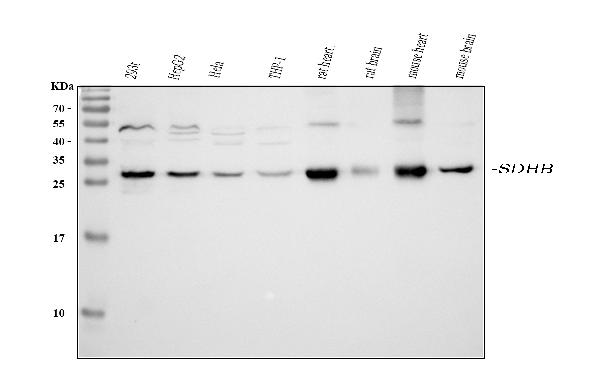
Click image to see more details
Figure 1. Western blot analysis of SDHB using anti-SDHB antibody (A01090).
Electrophoresis was performed on a 5-20% SDS-PAGE gel at 70V (Stacking gel) / 90V (Resolving gel) for 2-3 hours. The sample well of each lane was loaded with 30 ug of sample under reducing conditions.
Lane 1: human 293T whole cell lysates,
Lane 2: human HepG2 whole cell lysates,
Lane 3: human Hela whole cell lysates,
Lane 4: human THP-1 whole cell lysates,
Lane 5: rat heart tissue lysates,
Lane 6: rat brain tissue lysates,
Lane 7: mouse heart tissue lysates,
Lane 8: mouse brain tissue lysates.
After electrophoresis, proteins were transferred to a nitrocellulose membrane at 150 mA for 50-90 minutes. Blocked the membrane with 5% non-fat milk/TBS for 1.5 hour at RT. The membrane was incubated with rabbit anti-SDHB antigen affinity purified polyclonal antibody (Catalog # A01090) at 0.5 μg/mL overnight at 4°C, then washed with TBS-0.1%Tween 3 times with 5 minutes each and probed with a goat anti-rabbit IgG-HRP secondary antibody at a dilution of 1:5000 for 1.5 hour at RT. The signal is developed using an Enhanced Chemiluminescent detection (ECL) kit (Catalog # EK1002) with Tanon 5200 system. A specific band was detected for SDHB at approximately 29 kDa. The expected band size for SDHB is at 29 kDa.
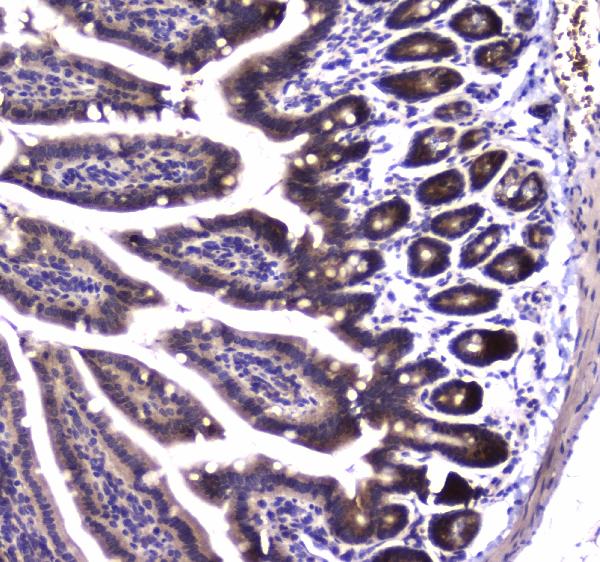
Click image to see more details
Figure 2. IHC analysis of SDHB using anti-SDHB antibody (A01090).
SDHB was detected in paraffin-embedded section of mouse small intestine tissue. Heat mediated antigen retrieval was performed in citrate buffer (pH6, epitope retrieval solution) for 20 mins. The tissue section was blocked with 10% goat serum. The tissue section was then incubated with 1μg/ml rabbit anti-SDHB Antibody (A01090) overnight at 4°C. Biotinylated goat anti-rabbit IgG was used as secondary antibody and incubated for 30 minutes at 37°C. The tissue section was developed using Strepavidin-Biotin-Complex (SABC)(Catalog # SA1022) with DAB as the chromogen.
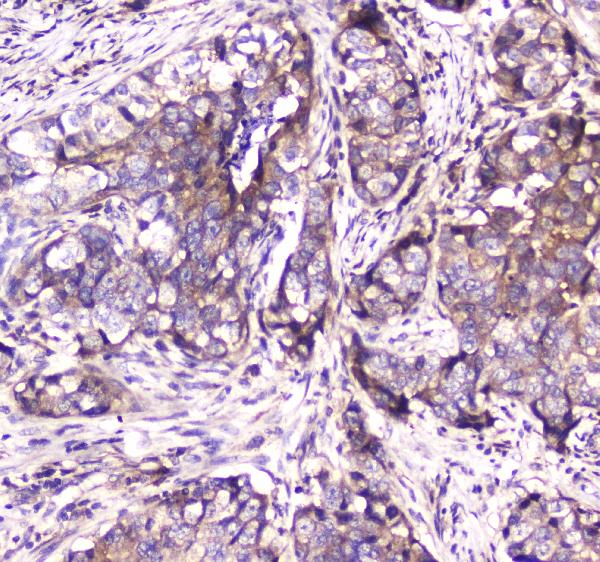
Click image to see more details
Figure 3. IHC analysis of SDHB using anti-SDHB antibody (A01090).
SDHB was detected in paraffin-embedded section of human mammary cancer tissue. Heat mediated antigen retrieval was performed in citrate buffer (pH6, epitope retrieval solution) for 20 mins. The tissue section was blocked with 10% goat serum. The tissue section was then incubated with 1μg/ml rabbit anti-SDHB Antibody (A01090) overnight at 4°C. Biotinylated goat anti-rabbit IgG was used as secondary antibody and incubated for 30 minutes at 37°C. The tissue section was developed using Strepavidin-Biotin-Complex (SABC)(Catalog # SA1022) with DAB as the chromogen.
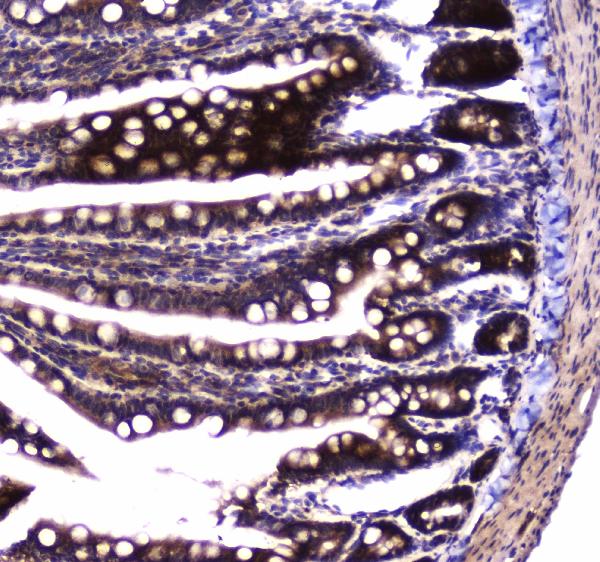
Click image to see more details
Figure 4. IHC analysis of SDHB using anti-SDHB antibody (A01090).
SDHB was detected in paraffin-embedded section of rat small intestine tissue. Heat mediated antigen retrieval was performed in citrate buffer (pH6, epitope retrieval solution) for 20 mins. The tissue section was blocked with 10% goat serum. The tissue section was then incubated with 1μg/ml rabbit anti-SDHB Antibody (A01090) overnight at 4°C. Biotinylated goat anti-rabbit IgG was used as secondary antibody and incubated for 30 minutes at 37°C. The tissue section was developed using Strepavidin-Biotin-Complex (SABC)(Catalog # SA1022) with DAB as the chromogen.
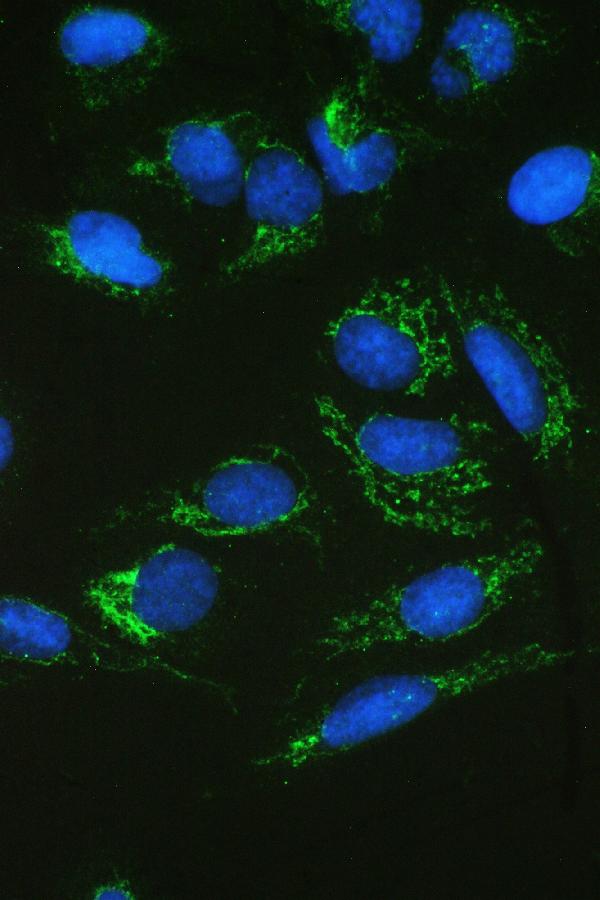
Click image to see more details
Figure 5. IF analysis of SDHB using anti-SDHB antibody (A01090).
SDHB was detected in immunocytochemical section of U20S cell. Enzyme antigen retrieval was performed using IHC enzyme antigen retrieval reagent (AR0022) for 15 mins. The cells were blocked with 10% goat serum. And then incubated with 2μg/mL rabbit anti-SDHB Antibody (A01090) overnight at 4°C. DyLight®488 Conjugated Goat Anti-Rabbit IgG (BA1127) was used as secondary antibody at 1:100 dilution and incubated for 30 minutes at 37°C. The section was counterstained with DAPI. Visualize using a fluorescence microscope and filter sets appropriate for the label used.
Protein Target Info & Infographic
Gene/Protein Information For SDHB (Source: Uniprot.org, NCBI)
Gene Name
SDHB
Full Name
Succinate dehydrogenase [ubiquinone] iron-sulfur subunit, mitochondrial
Weight
31.63kDa
Superfamily
succinate dehydrogenase/fumarate reductase iron-sulfur protein family
Alternative Names
Succinate dehydrogenase [ubiquinone] iron-sulfur subunit, mitochondrial; Iron-sulfur subunit of complex II; Ip; SDHB; SDH; SDH1 SDHB CWS2, IP, MC2DN4, PGL4, SDH, SDH1, SDH2, SDHIP succinate dehydrogenase complex iron sulfur subunit B succinate dehydrogenase [ubiquinone] iron-sulfur subunit, mitochondrial|iron-sulfur subunit of complex II|succinate dehydrogenase complex, subunit B, iron sulfur (Ip)
*If product is indicated to react with multiple species, protein info is based on the gene entry specified above in "Species".For more info on SDHB, check out the SDHB Infographic

We have 30,000+ of these available, one for each gene! Check them out.
In this infographic, you will see the following information for SDHB: database IDs, superfamily, protein function, synonyms, molecular weight, chromosomal locations, tissues of expression, subcellular locations, post-translational modifications, and related diseases, research areas & pathways. If you want to see more information included, or would like to contribute to it and be acknowledged, please contact [email protected].
Specific Publications For Anti-SDHB Antibody Picoband® (A01090)
Hello CJ!
No publications found for A01090
*Do you have publications using this product? Share with us and receive a reward. Ask us for more details.
Recommended Resources
Here are featured tools and databases that you might find useful.
- Boster's Pathways Library
- Protein Databases
- Bioscience Research Protocol Resources
- Data Processing & Analysis Software
- Photo Editing Software
- Scientific Literature Resources
- Research Paper Management Tools
- Molecular Biology Software
- Primer Design Tools
- Bioinformatics Tools
- Phylogenetic Tree Analysis
Customer Reviews
Have you used Anti-SDHB Antibody Picoband®?
Submit a review and receive an Amazon gift card.
- $30 for a review with an image
0 Reviews For Anti-SDHB Antibody Picoband®
Customer Q&As
Have a question?
Find answers in Q&As, reviews.
Can't find your answer?
Submit your question
5 Customer Q&As for Anti-SDHB Antibody Picoband®
Question
We want using your anti-SDHB antibody for respiratory electron transport studies. Has this antibody been tested with western blotting on small intestine tissue? We would like to see some validation images before ordering.
Verified Customer
Verified customer
Asked: 2020-01-16
Answer
Thanks for your inquiry. This A01090 anti-SDHB antibody is validated on human a549, a549 whole cell lysates, rat heart tissue, brain tissue, mouse heart tissue, small intestine tissue, mammary cancer tissue. It is guaranteed to work for ELISA, IF, IHC-P, ICC, WB in human, mouse, rat. Our Boster guarantee will cover your intended experiment even if the sample type has not been be directly tested.
Boster Scientific Support
Answered: 2020-01-16
Question
We have observed staining in mouse fibroblast. Are there any suggestions? Is anti-SDHB antibody supposed to stain fibroblast positively?
Verified Customer
Verified customer
Asked: 2019-11-19
Answer
From what I have seen in literature fibroblast does express SDHB. From what I have seen in Uniprot.org, SDHB is expressed in muscle of leg, liver, uterus, brain, fibroblast, among other tissues. Regarding which tissues have SDHB expression, here are a few articles citing expression in various tissues:
Brain, Pubmed ID: 15489334
Fibroblast, Pubmed ID: 2494655
Liver, Pubmed ID: 2302193, 7622059, 24275569
Uterus, Pubmed ID: 14702039
Boster Scientific Support
Answered: 2019-11-19
Question
We ordered your anti-SDHB antibody for WB on uterus in the past. I am using human, and We are going to use the antibody for ICC next. My lab would like examining uterus as well as brain in our next experiment. Could give a recommendation on which antibody would work the best for ICC?
Verified Customer
Verified customer
Asked: 2018-12-26
Answer
I viewed the website and datasheets of our anti-SDHB antibody and it appears that A01090 has been tested on human in both WB and ICC. Thus A01090 should work for your application. Our Boster satisfaction guarantee will cover this product for ICC in human even if the specific tissue type has not been validated. We do have a comprehensive range of products for ICC detection and you can check out our website bosterbio.com to find out more information about them.
Boster Scientific Support
Answered: 2018-12-26
Question
Our lab were happy with the WB result of your anti-SDHB antibody. However we have seen positive staining in brain mitochondrion inner membrane using this antibody. Is that expected? Could you tell me where is SDHB supposed to be expressed?
Verified Customer
Verified customer
Asked: 2018-10-30
Answer
According to literature, brain does express SDHB. Generally SDHB expresses in mitochondrion inner membrane. Regarding which tissues have SDHB expression, here are a few articles citing expression in various tissues:
Brain, Pubmed ID: 15489334
Fibroblast, Pubmed ID: 2494655
Liver, Pubmed ID: 2302193, 7622059, 24275569
Uterus, Pubmed ID: 14702039
Boster Scientific Support
Answered: 2018-10-30
Question
We are currently using anti-SDHB antibody A01090 for rat tissue, and we are happy with the ICC results. The species of reactivity given in the datasheet says human, mouse, rat. Is it possible that the antibody can work on canine tissues as well?
Verified Customer
Verified customer
Asked: 2017-12-27
Answer
The anti-SDHB antibody (A01090) has not been validated for cross reactivity specifically with canine tissues, but there is a good chance of cross reactivity. We have an innovator award program that if you test this antibody and show it works in canine you can get your next antibody for free. Please contact me if I can help you with anything.
Boster Scientific Support
Answered: 2017-12-27




